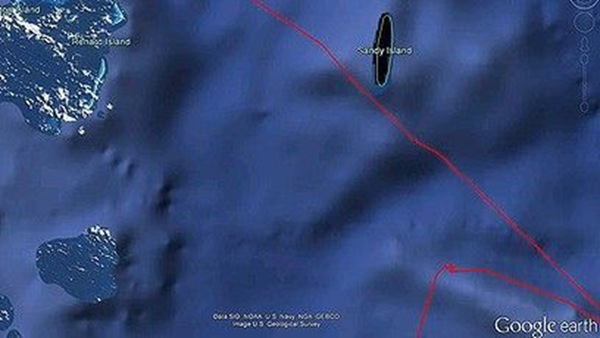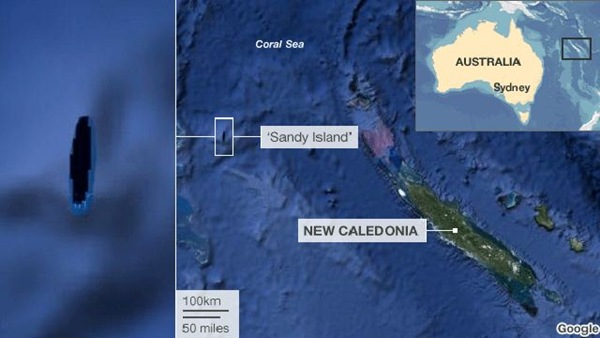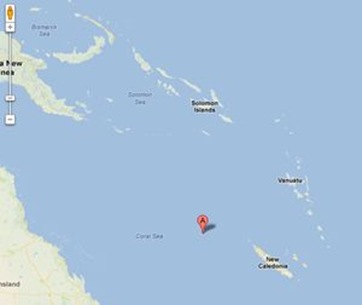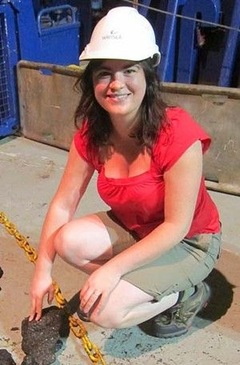
Where did it go? Scientists 'undiscover' Pacific island
By Nicky Phillips, The Sydney Morning Herald, 22 November 2012.
By Nicky Phillips, The Sydney Morning Herald, 22 November 2012.
The mystery of the missing island: A team of Australian scientists discover that an island in the Pacific,
which appears on maps and weather charts, doesn't exist. Click here to view the Sydney Morning
Herald video.
which appears on maps and weather charts, doesn't exist. Click here to view the Sydney Morning
Herald video.
Most explorers dream of discovering uncharted territory, but a team of Australian scientists have done the exact opposite.
They have found an island that doesn't exist.
Even on-board the ship, the weather maps the captain had showed an island in this location. - Dr Maria Seton, University of Sydney
Sandy island - as it appears in Google Earth [via io9.com]
The island, named Sandy Island on Google Earth, also exists on marine charts and world maps and allegedly sits between Australia and New Caledonia in the south Pacific.
The island that isn't...how it is highlighted on a map
Sandy Island on Google Maps [via io9.com]
But when the voyage's chief scientist, Maria Seton, and her crew sailed past where the island should be, they found nothing but blue ocean.
"We became suspicious when the navigation charts used by the ship showed a depth of 1400 metres in an area where our scientific maps and Google Earth showed the existence of a large island," Dr Maria Seton, a geologist from the University of Sydney, said.
"Somehow this error has propagated through to the world coastline database from which a lot of maps are made."
The missing island has regularly appeared in scientific publications since at least 2000.
"Even on-board the ship, the weather maps the captain had showed an island in this location," Dr Seton [pictured on the right on board the RV Southern Surveyor. Photo: Supplied] said.
Neither the French government - the invisible island would sit within French territorial waters if it existed - nor the ship's nautical charts, which are based on depth measurements, had the island marked on their maps.
Dr Seton had no idea how the island came to be on so many maps, but she is determined to get to the bottom of the mystery.
Steven Micklethwaite from the University of Western Australia said, "We all had a good giggle at Google as we sailed through the island, then we started compiling information about the seafloor, which we will send to the relevant authorities so that we can change the world map."
Mike Prince, the director of charting services for the Australian Hydrographic Service, a department within the Navy that produces the country’s official nautical charts, said the world coastline database incorporated individual reports that were sometimes old or contained errors.
"We take anything off that database with a pinch of salt," he said.
While some map makers intentionally include phantom streets to deter copyright infringements, that was not standard practice with nautical charts, said Mr Prince.
"[That would] reduce confidence in what is actually correct," he said.
Nabil Naghdy, the product manager of Google Maps for Australia and New Zealand, said Google Earth consulted a variety of authoritative public and commercial data sources in building its maps.
"The world is a constantly changing place, and keeping on top of these changes is a never-ending endeavour,’’ Mr Naghdy said.
He encouraged users to alert Google to incorrect entries using the 'Report a Problem' tool, found at the bottom right corner of the map, which they would then confirm with other users or data providers.
The discovery took place on-board the RV Southern Surveyor, Australia's Marine National Facility research vessel, during a 25-day research trip in the eastern Coral Sea.
Large fragments of eastern Australia split from the mainland as the Tasman Sea formed about 100 million years ago, when Australia split apart from the super continent Gondwana, which included Antarctica, India and Africa.
"This dispersed all the continental fragments in the area, which subsided and [went] below sea level," Dr Seton, who docked in Brisbane on Monday, said.
"We went to find those fragments of our country," she said.
The team collected 197 different rock samples, more than 6800 km of marine geophysical data and mapped over 14,000 square kilometres of the ocean floor.
They also recovered limestone, which forms from near surface coral reefs, from a depth of three kilometres.
"That means we've had this massive drowning of the area. That was a surprising discovery," said Dr Seton.
Video: Mysterious 'sandy' island disappears off the map
Source: YouTube






No comments:
Post a Comment
Please adhere to proper blog etiquette when posting your comments. This blog owner will exercise his absolution discretion in allowing or rejecting any comments that are deemed seditious, defamatory, libelous, racist, vulgar, insulting, and other remarks that exhibit similar characteristics. If you insist on using anonymous comments, please write your name or other IDs at the end of your message.